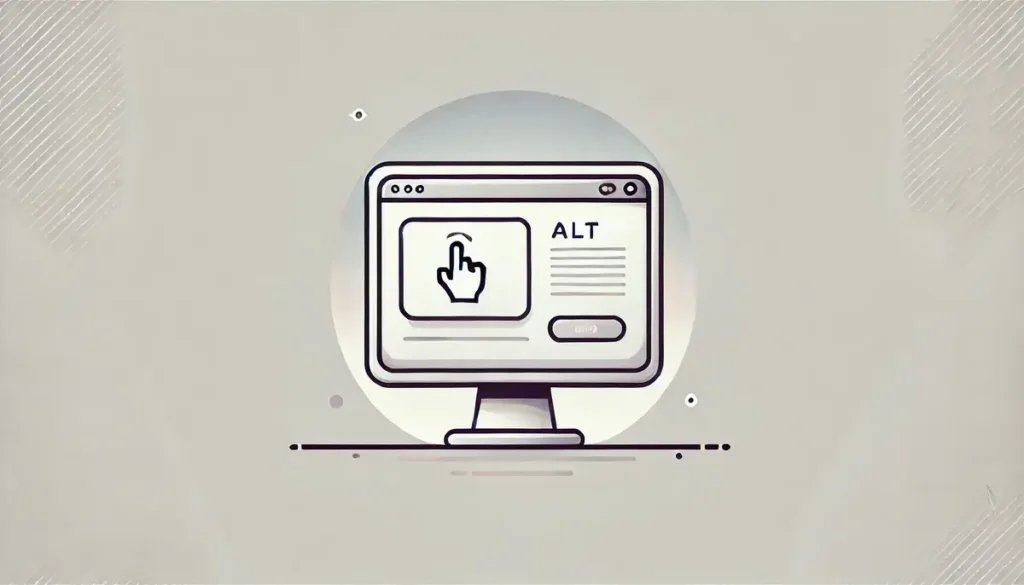Ever trip over a curb because a missing sidewalk description failed to warn you? That’s kind of what your website does to visitors with visual impairments when images lack alt text. But fear not – alt text is here to be your secret weapon, not a digital curb.
This guide will be your alt text guru, teaching you how to craft clear, concise descriptions that enhance accessibility and impress search engines. We’ll unveil common pitfalls (think overly verbose ramblings or nonexistent descriptions) and show you how to navigate them like a pro.
So, ditch the website guilt trips and unleash the power of alt text. Let’s make your website a welcoming space for everyone while giving it a little SEO nudge in the process. Ready to become an alt text champion? Dive in!
Basics of Alt Text
Alt text is a critical component of website accessibility, enhancing the user experience for visually impaired visitors who depend on screen readers. It also plays an integral role in search engine optimization, affecting how search engines index and understand images.
What is Alt Text?
Alt text, short for “alternative text,” is a concise description associated with an image on a webpage. It provides a textual alternative to visual content, allowing screen readers to convey the essence of an image to visually impaired users. Alt text also supports SEO efforts by enabling search engines to understand the content of images better, improving the likelihood that they will appear in search results when relevant queries are made.
How Does Alt Text Work in HTML?
In HTML, alt text is added to an image through the alt attribute in the <img> tag. When an image fails to load on a webpage, the alt text will display in place of the image, informing the user about what they’re missing. This is particularly beneficial if the image contains important information or contributes to the page content’s context and meaning.
Implementing effective alt text involves balancing accuracy and brevity. It’s crucial to describe the image succinctly while ensuring that the description remains relevant to both the page content and the image context. It must be concise—typically no more than 125 characters—to ensure that screen readers can easily interpret the image and keep the user experience smooth and engaging.
Importance of Alt Text
Accessibility Benefits
Integrating descriptive alt text with your images ensures that all users, regardless of visual ability, can understand the visual content offered on a web page. These descriptions facilitate a better browsing experience by narrating what the image depicts, which is essential for assistive technology users. When alt text is effectively utilized, it can transform the digital landscape into a more inclusive space. Information conveyed through images becomes accessible to everyone, thereby improving the comprehensibility and navigability of the site.
SEO Impact
Beyond accessibility, alt text significantly influences how search engines perceive and rank web content. Search engines utilize the text associated with images to gauge the context and relevance of a webpage. If the alt text describes the image effectively while incorporating key search terms naturally, it enhances SEO performance. This improved recognition by search engines boosts the page’s visibility and drives more organic traffic to the site. Thus, if concisely and contextually aligned with the site’s content, strategically crafted alt text can lead to better indexing and higher search rankings.
Crafting Effective Alt Text
This section outlines the qualities of good alt text and highlights common mistakes businesses might want to avoid.
Key Characteristics of Good Alt Text
Effective alt text serves several critical functions: it provides clarity, improves accessibility, and enhances SEO rankings. Here are some key characteristics to aim for:
- Descriptive and Concise: The ideal alt text describes the image succinctly. For example, instead of “bird,” use “a blue jay perched on a tree branch.”
- Contextually Relevant: Alt text should relate to the surrounding content, explaining the image’s relevance to the overall topic.
- Use of Plain Language: Avoid technical jargon unless it’s relevant to the target audience, ensuring the alt text remains understandable to all users.
- No Keyword Stuffing: Insert keywords naturally, as forced keywords reduce the readability and effectiveness of alt text.
- Avoidance of Redundant Phrasing: Phrases like “image of” or “picture of” are unnecessary; it’s obvious that the alt describes an image.
Common Alt Text Mistakes to Avoid
While alt text increases a site’s accessibility and SEO, common pitfalls can detract from these benefits. Here are frequent errors to avoid:
- Being Overly Verbose: Long descriptions can overwhelm the user. If alt text exceeds 125 characters, it may be cut off by some screen readers.
- Leaving Alt Text Blank: Every image that conveys meaning should have alt text. Decorative images, however, can use an empty alt attribute (alt=””).
- Using Non-Descriptive Text: Alt text like “logo” or “spacer” provides no value to users who rely on screen readers. Instead, describe the logo or omit alt text for purely decorative elements.
- Ignoring the User Experience: Alt text should enrich the user’s understanding of page content. Disconnected or irrelevant text can confuse visitors and diminish their experience.
By avoiding these common errors, creators ensure that their alt text remains an asset rather than a barrier to effective communication and site usability.
Optimal Length of Alt Text
For effective communication, alt text should typically range between 100 and 150 characters. This length strikes a balance, providing enough detail to describe the image contextually while remaining succinct enough to maintain user attention and not overwhelm assistive technologies. A concise description ensures users who rely on screen readers can understand the image’s relevance without unnecessary elaboration. For instance, “A child holding a colorful balloon” uses just 34 characters and conveys the essential information clearly.
Factors Influencing Alt Text Length
Several factors determine the precise length of alt text, ensuring both clarity and utility:
- Image Complexity: The more detailed an image, the more characters it might need. Simple images like icons require fewer words, while a complex graph needs to be more accurately described.
- Contextual Relevance: Alt text must align with the surrounding content on the webpage. Images central to the content might need detailed descriptions compared to decorative ones that require minimal text.
- Functionality: If the image includes functional elements like buttons or links, the alt text must convey this functionality, possibly extending the typical character count.
- SEO Considerations: While alt text should primarily aim to improve accessibility, incorporating relevant keywords can help with image search indexing without keyword stuffing.
Considering these factors ensures that alt text fulfills its role effectively, enhancing both accessibility and SEO without compromising either. Each image demands a tailored approach to determine the optimal length of its alt text, fostering better engagement and inclusivity.
When to Use Alt Text
Alt text must be used whenever an image is inserted into a web page. Images that convey information, including graphs, infographics, and photos that illustrate article content, are essential. If an image is purely decorative, it’s still a good practice to include alt text, albeit with a minimal descriptor or an empty alt attribute (alt=””) to ensure screen readers properly ignore the image. This practice supports those with visual impairments and enhances the site’s SEO by providing context that search engines can index.
How to Add Alt Text to Images
- Locate the Image Tag: In HTML, locate the <img> tag where the image is embedded.
- Edit the Alt Attribute: Add the alt attribute inside the image tag. It should look like this: <img src=”image.jpg” alt=”Descriptive text here”>.
- Be Descriptive: Include a concise description that reflects the image’s contents and context. If the image describes something specific, such as a chart, briefly mention what it depicts, like “2018 Sales Growth Chart.”
- Keep It Short: Although it’s tempting to be very detailed, remember the 100 to 150-character range. This length is optimal for both SEO and accessibility.
- Test for Accessibility: Use tools such as screen readers to test how the alt text reads to users with visual impairments. This step ensures that the chosen words effectively convey the intended information.
Each image becomes an opportunity to both inform and engage all users, regardless of how they access your site, reinforcing inclusivity and enhancing overall user experience.
Conclusion
Crafting the right alt text is not just about adhering to a character count; it’s about making the web more inclusive and enhancing SEO. By keeping alt text within the 100 to 150-character range, content creators can ensure they provide enough detail without overwhelming the user. Regularly testing alt text with tools like screen readers verifies its effectiveness in communication. Ultimately, thoughtful and well-implemented alt text practices are key to improving accessibility and boosting SEO, which benefits everyone.


